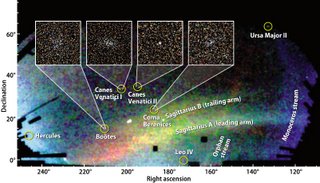Milky Way family grows

Like a Goddess, the Milky Way is truly something to be awed by. We live in a disk of stars so vast, that if our Sun was the size of the dot of an "i" on this page, the Milky Way would stretch from Los Angeles to New York City. Hundreds of billions of stars, our Sun among them, orbit around the dense center of our galaxy, passing in and out of giant dust clouds, the debris of the lives of the stars.
Residing in the outskirts of the Milky Way, our Sun takes 226 million years to make one orbit around the dense center of the galaxy. Even so, our motion is far from leisurely. The Sun, along with all our planets, is moving at well over 400,000 miles per hour around a bulging central swarm of millions of stars concealing a supermassive black hole in their midst. And we are part of all this. Some of the stars we see in the sky, although we don't know which ones, formed out of the same birth cloud the Sun did. Other stars, long dead, seeded our solar system with the rich chemicals needed to form life.
Not only does the Sun belong to a vast extended family, but the Milky Way does as well. Take a fairly basic question: what is the closest galaxy to our own? A lot of people might say the Andromeda Galaxy, which is, in fact, the closest large spiral to us, about two million light-years away. Andromeda is so close, in fact, that it is gravitationally bound to the Milky Way, and is one of the only galaxies in the sky that is moving toward us. Other, somewhat more astronomically savvy people might name the Magellanic Clouds as the closest galaxies. The Large and Small Magellanic Clouds are two small, blobby galaxies that actually orbit the Milky Way, and are about 180,000 and 210,000 light-years away, respectively.
And up until the last few years, everyone seemed pretty pleased with this answer; after all, these were the closest galaxies we could see in the sky. But we were wrong to trust our eyes. As it turns out, there are at least two other galaxies that are much, much closer. Part of the reason we missed them, in fact, is that they are so close; they are actually colliding with the disk of the Milky Way. In a very real way, they snuck up from behind us, hiding behind the stars, dust, and gas that fill the volume of the Milky Way's disk.
So how could we have missed two entire galaxies that are colliding with us? The answer has a lot to do with how we know we live in a spiral galaxy in the first place. I mean, you can't look up into the sky and see the spiral structure of our galaxy, so how do we know it's there? Most people are familiar with the dim, blurry band of light that crosses the sky, which ancient people from several cultures likened to a path of milk. This "Milky Way" is actually the combined light of billions of stars in the plane of our galaxy, and people from at least the eighteenth century have realized that our galaxy has a flattened shape.
The Milky Way: a Growing Galactic Family
by Michelle Thaller @ Spitzer Science Centre

_______________________________________________________
Credit: Vasily Belokurov, SDSS-II Collaboration and reproduced by permission,
copyright 2007, Astronomy magazine, Kalmbach Publishing Co.
Seven or Eight Dwarf Galaxies Discovered Orbiting the Milky Way
The discovery was announced 9 January 2007, during a press conference at the American Astronomical Society's meeting in Seattle, Washington. The galaxies were discovered as part of the Sloan Digital Sky Survey (SDSS-II), the most ambitious survey of the sky ever undertaken.
These dwarf galaxies have been captured by the gravity of the Milky Way and most eventually will merge with our own galaxy.
Dwarf galaxies contain, at most, a few million stars. The new dwarfs have some unusual properties. Several of the newly discovered systems appear to be on the verge of disruption, probably by the tidal gravity of the Milky Way - and the 'Ursa Major II' dwarf already seems to be in several pieces. "They look as though they're being ground up"
Current theories of galaxy assembly suggest that many - perhaps all - of the stars in the halo and thick disk of the Milky Way originated in smaller dwarf galaxies, which were dissolved when they merged into the Milky Way itself.
The new dwarfs are really just the crumbs from the galactic feast. "Most of the merging happened early on - billions of years ago - and what we're seeing here are the leftovers."
_______________________________________________________
_______________________________________________________
Famous Quotes: Justice is truth in action. Benjamin Disraeli
_______________________________________________________
_______________________________________________________


<< Home